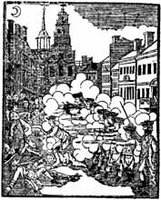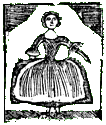What Happened to the Boston Massacre Defendants?
Nine days later, fellow defendants Edward Montgomery and Mathew Kilroy joined them, each with one hand bandaged after branding.
Lt. Col. William Dalrymple of the 14th had already decided how he would send those men back to the 29th Regiment, which had been moved to New Jersey. The commander wrote:
A bad disposition appearing in the Soldiers who were confined I shall send them round by sea, we have but too much reason to suspect their ententions to desert they are not at all to be depended on.“I do not chuse to trust them any other way,” he added on 17 December. It would be great to know why Dalrymple was suspicious, but we don’t.
Until recently, the story of those eight British enlisted men stopped there. But Don Hagist has been doing thorough research on British troops during the War for Independence, culminating in the new book Noble Volunteers. Don found more information on some of those soldiers in the muster rolls and Chelsea pensioner records, which he generously let me publish here. I’ve added information on others over the years. So here’s what happened to all the defendants.
By May 1771, William Wemys was promoted to sergeant. He was still a sergeant when the company was stationed at Chatham, England, on 29 July 1775. His company’s muster rolls end there, so we lose track of him.
In the grenadier company, John Carroll and William Macauley were both made corporals. William Warren, despite being the tallest of the defendants, transferred out of the grenadiers to another company in the 29th.
As I related in this posting from 2006, Pvt. James Hartigan died on 4 Nov 1771 at the 29th’s next assignment in St. Augustine, Florida.
The regiment was in England when the war began, and army commanders decided to send it back to North America. That could have exposed Pvts. Montgomery and Kilroy to being captured by the American rebels, their hands still bearing the brand of the Massacre. On 22 Feb 1776 those two men appeared before a board of examiners for military pensions administered by Chelsea Hospital. Montgomery, age forty-one, was deemed “Worn Out,” and Kilroy, only twenty-eight, was found to have “a Lame Knee.” The board discharged both men from the army with pensions.
The rest of the 29th Regiment sailed to Canada, where different fates awaited different companies. Pvt. Warren and Pvt. Hugh White, the sentry, spent the American war at separate stations in Canada. White was finally discharged from the army on 10 Nov 1789, then aged forty-nine.
John Carroll, promoted to sergeant by February 1777, and Cpl. Macauley were still with the 29th’s grenadier company, which was assigned to Gen. John Burgoyne’s invasion force. Those two men might therefore have become part of the “Convention Army” of prisoners of war marched from Saratoga to Cambridge at the end of that year. But there’s no record of anyone in Massachusetts recognizing those two soldiers from the Massacre trial.
I discussed the evidence about Capt. Thomas Preston’s retirement here. He started to receive an annual £200 royal pension in 1772, and it continued until at least 1790. In the 1780s Preston was living in Dublin.
Of the defendants in the third trial, I profiled Hammond Green in this posting. He evacuated Boston in 1776 as a Customs employee, and his wife and children followed the next year. The royal government gave Green a Customs job at his new home of Halifax, and he was still working there in 1807.
Thomas Greenwood was working for the Customs service in 1770 but wasn’t listed among the employees who evacuated in 1776. I don’t know anything more solid about him.
Edward Manwaring retained the post of chief Customs officer on the Gaspé peninsula until 1785 when he was succeeded by his neighbor Felix O’Hara.
John Munro carried on his business as a notary “at his Office South Side of the Town House.” The 12 Jan 1775 issue of the Massachusetts Spy reported that he had died the previous Tuesday at the age of thirty-nine after a “tedious illness.” He was buried out of Christ Church on 13 January.







